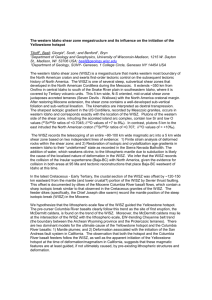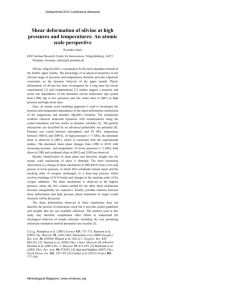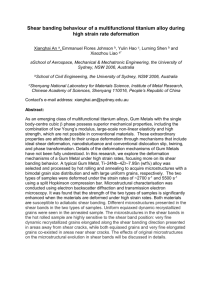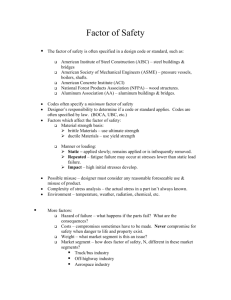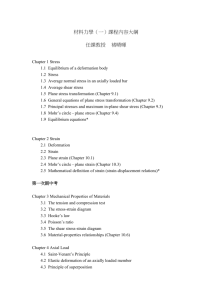The Idaho Syntaxis Talk GSA 2013 V2.2
advertisement
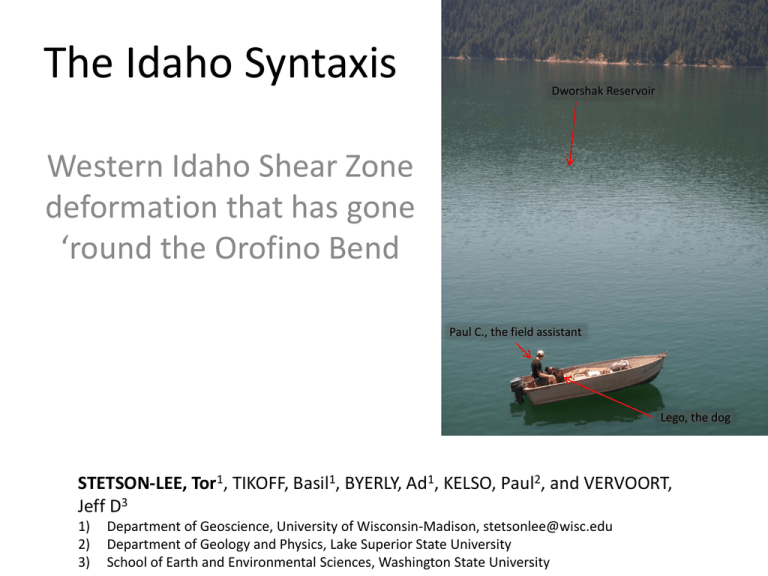
The Idaho Syntaxis Dworshak Reservoir Western Idaho Shear Zone deformation that has gone ‘round the Orofino Bend Paul C., the field assistant Lego, the dog STETSON-LEE, Tor1, TIKOFF, Basil1, BYERLY, Ad1, KELSO, Paul2, and VERVOORT, Jeff D3 1) 2) 3) Department of Geoscience, University of Wisconsin-Madison, stetsonlee@wisc.edu Department of Geology and Physics, Lake Superior State University School of Earth and Environmental Sciences, Washington State University Outline • Geologic Background of Orofino Area • Kinematic Information From Field Observations • Previous Models for the Dog-leg (90° bend) Geometry • New Model: The WISZ Syntaxis •Paleocontinental margin defined by 87Sr/86Sr 0.706 isopleth. •Western Idaho Shear Zone fabric co-located with 0.706 line near McCall. •Trans-Idaho Shear Zone (named after TransIdaho lineament) located northeast of Orofino. Location Orofino McCall Modified from Tikoff et al. 2001 Modified from Lewis et al. 2012 Distinct foliation defines the two shear zones in the field. 50 km lower hemisphere equal area projections field observations macroscopic fabric N N Reverse sense of shear is consistent with study of Strayer et al. (1989). Reverse indicators near Orofino. view is towards the west, parallel to lineation and perpendicular to foliation XPL field observations up microscopic fabric N PPL Reverse sense of shear near Orofino. 4 mm view is parallel to lineation and perpendicular to and foliation and towards the west 4 mm field observations macroscopic fabric Looking perpendicular to lineation, we also observed a consistent (sinistral) sense of shear. Rock fabric near Orofino showing sinistral sense of shear. view is perpendicular to lineation and foliation compass points north in both photos Orofino Area Vorticity triclinic deformation (or inclined transpsression); vorticity vector oblique to lineation McCall Area Vorticity The vorticity vector represents the axis around which the rock fabric is rotated during deformation. transpressional deformation (monoclinic); vorticity vector parallel to lineation approximate possible range of angle of convergence (50°85°) Diagrams modified from Giorgis et al. 2006 DEFORMATION ALONG 0.706 LINE Orofino/Dworshak area: sinistral-reverse movement. At least 30 km of displacement across the shear zone here (Strayer et al. 1989). Orofino McCall Western Idaho shear zone in McCall area: dextral transpressive deformation. Boise Truncation Model •NW-SE oriented shear zone cuts across Western Idaho shear zone •~70 Ma folded dike in Orofino shear zone corroborates truncation possibility (McClelland and Oldow, 2007) From McClelland and Oldow, 2007 Progressive Rotation & Tightening Model •Tightening of the bend due to oblique dextral convergence and rotation of Blue Mountains terrane (Lund et al., 2008) •Accommodation of motion along second shear zone to northeast From Lund et al. 2008 Age Constraints near Orofino •U-Pb crystallization ages AND Ar-Ar cooling ages are consistent with known ages of N-S oriented WISZ •Indicates that E-W striking fabrics at Orofino are part of Western Idaho shear zone Western Idaho shear zone deformation goes ‘round the Bend! Paleomagnetic Data •Entirety of Western Idaho shear zone has rotated 30 degrees clockwise. Data presented by Byerly et al. (this meeting, Monday – T108) •This data, combined with UPb data, support large scale rotation of the continental margin. The entire western Idaho shear zone (& 0.706 line) is rotated 30 degrees after 90 Ma! The original geometry of the WISZ Orofino/Dworshak area: left-lateral oblique reverse sense of shear. Orofino original foliation orientation rotation modern foliation orientation McCall McCall area: right lateral transpressive sense of shear. original foliation orientation rotation pre-Miocene foliation orientation Boise Accretionary Convergence • Vorticity analysis on the fabrics near McCall indicate a ~50 angle of convergence. • If this angle of convergence describes regional motion AND the bend pre-existed WISZ deformation……. N Orofino clockwise rotated clast counter clockwise rotated clast McCall 85° 60° 50° S Modified from Giorgis et al. 2006 Boise Same Shear Zone, Different Shear …then it also explains the two senses of shear along the same shear zone boundary. A convergence angle of about 50 degrees leads to dextral transpression along the N-S oriented margin and sinistral reverse shearing along the EW striking portion of the boundary zone. Orofino McCall Boise The Western Idaho Shear Zone Through Time Modified from Lund 2008 Tectonic evolution inferred from geologic and paleomagnetic data. Active shearing along WISZ Sense of shear varies from dextral to sinistral—this geometry is a syntaxis. The Western Idaho Shear Zone Through Time Cessation of shearing on the WISZ Emplacement of tonalite sill Conclusions The Orofino bend: 1. Is the edge of North America (cratonic margin); 2. Resulted from Proterozoic rifting (transform/ridge system); 3. Is deformed everywhere by the Western Idaho shear zone with different kinematics in different places; 4) Was rotated clockwise 30° sometime after 90 Ma, possibly related to Sevier thrusting. The Western Idaho shear zone represents deformation in a syntaxis on the North American margin.

